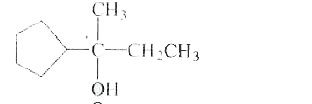The alakene C6H10 producing OHC(CH2)4CHO on ozonolysis is :
Hexene - 1
Hexene - 3
Cyclohexene
1-Methylcyclohexene
The correct Answer is:C
To solve the problem, we need to identify which alkene, when subjected to ozonolysis, produces the compound OHC(CH2)4CHO. Let's break down the solution step by step.
Step 1: Understand Ozonolysis
Ozonolysis is a reaction where alkenes react with ozone (O3) to form ozonides, which can then be reduced to carbonyl compounds (aldehydes or ketones) using reducing agents like zinc or hydrogen peroxide.
Step 2: Analyze the Given Product
The product OHC(CH2)4CHO can be rewritten as:
- This indicates a compound with two aldehyde groups (CHO) and a central carbon atom that is connected to four CH2 groups.
Step 3: Identify Possible Alkenes
We will evaluate the given options to see which alkene can yield the desired product upon ozonolysis.
1. 1-Hexene (CH3-CH2-CH2-CH2-CH=CH2):
- On ozonolysis, it produces:
- CH3-CH2-CH2-CH2-CHO + HCHO
- This does not match our desired product.
2. 3-Hexene (CH3-CH2-CH=CH-CH2-CH3):
- On ozonolysis, it produces:
- 2 CH3-CHO (two molecules of propanal)
- This also does not match our desired product.
3. Cyclohexene:
- On ozonolysis, it forms:
- Two molecules of CHO and a central carbon chain with four CH2 groups.
- This matches our desired product OHC(CH2)4CHO.
4. 1-Methylcyclohexene:
- On ozonolysis, it produces:
- CH3C(=O)CH2CH2CH2CHO
- This does not yield the desired product.
Step 4: Conclusion
After analyzing all the options, we find that the alkene that produces the desired product OHC(CH2)4CHO upon ozonolysis is Cyclohexene.
Final Answer
The alkene C6H10 producing OHC(CH2)4CHO on ozonolysis is Cyclohexene.
---
Ozonolysis is a reaction where alkenes react with ozone (O3) to form ozonides, which can then be reduced to carbonyl compounds (aldehydes or ketones) using reducing agents like zinc or hydrogen peroxide.
The product OHC(CH2)4CHO can be rewritten as:
- This indicates a compound with two aldehyde groups (CHO) and a central carbon atom that is connected to four CH2 groups.
We will evaluate the given options to see which alkene can yield the desired product upon ozonolysis.
- On ozonolysis, it produces:
- CH3-CH2-CH2-CH2-CHO + HCHO
- This does not match our desired product.
- On ozonolysis, it produces:
- 2 CH3-CHO (two molecules of propanal)
- This also does not match our desired product.
- On ozonolysis, it forms:
- Two molecules of CHO and a central carbon chain with four CH2 groups.
- This matches our desired product OHC(CH2)4CHO.
- On ozonolysis, it produces:
- CH3C(=O)CH2CH2CH2CHO
- This does not yield the desired product.
After analyzing all the options, we find that the alkene that produces the desired product OHC(CH2)4CHO upon ozonolysis is Cyclohexene.
The alkene C6H10 producing OHC(CH2)4CHO on ozonolysis is Cyclohexene.
Similar Questions
Knowledge Check
An organic compound C4H6 on reductive ozonolysis gives HCHO,CO2andCO3CHO. Find structure of compound.
AH2C=CH−CH=CH2BCH3−CH=C=CH2C DH3C−C≡C−CH3
DH3C−C≡C−CH3A 3∘ optically active alcohol C9H18O 'A' on dehydration with conc. H2SO4 produces B(C9H16) which exists in two stereoisomeric forms. For ozonolysis of B followed by work up with Zn−H2O produces CH3−C∣∣O−HandC(C7H12O). C on treatment with LiAlH4 produces D(C7H14O). D on dehydration produced
 Identify the correct answer.AA is
Identify the correct answer.AA is BA is
BA is CD is
CD is DD is
DD is
A white precipitate was formed slowly when silver nitrate was added to compound (A) with molecular formula C6H13Cl.Compound (A) on treatment with hot alcoholic potassium hydroxide gave a misture of two isomeric alkenes (B) and (C), havinig the formuls C6H12. The mixture of (B) and (C), on ozonolsis, furnished four compounds.
i. CH3CHO,ii C2H5CHO
iii. CH3COCH3,(iv) CH3−CH∣CH3−CHO
What are the structures of (A),(B)and (C) ?
View SolutionAn unsaturated fatty acid on ozonolysis yields one aldehyde H3C(CH2)7CHO and an aldehyde monocarboxylic acid OHC(CH2)7COOH. Write down the structure and name of the acid.
View SolutionWhich of the following compounds on oxidation with (CH3COO)4 Pd would give the product OHC(CH2)4CHO ?
View SolutionTwo different Grignard reagents (X) and (Y ) produce C6H5CH2C(CH3)2OH on reaction with (P) and (Q) respectively. Give the structure of (X),(Y),(P) and (Q).
View SolutionThe reaction of C6H5CH=CHCH3 with HBr produces :
View SolutionHydrocarbon (A) C6H10 on treatment with H2Ni,H2/Lindlar's catalyst or Na/liq. NH3 forms three different reduction products (B), (C), (D) respectively. (A) does not form any salt with ammonical AgNO3 solution, but (E) forms salt on heating with NaNH2 in an inert solvent. Compound (E) reacts with CH3l to give (F). Compound (D) on oxidative ozonolysis gives n-butanoic acid along with other product.
(F) on ozonolysis will produce -
View Solution
